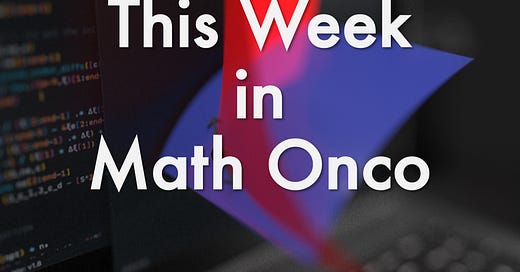This week in MathOnco 244
Collagen matrices, epigenetics in cancer, interdisciplinary research, AI pitfalls, and more.
“This week in Mathematical Oncology” — Feb. 23, 2023
> mathematical-oncology.org
From the editor:
Today we feature articles on collagen matrices, epigenetics in cancer, interdisciplinary research, AI pitfalls, and more.
By the way — Kristin Swanson & Sandy Anderson are organizing “MathOnc23“ in Phoenix (April 30 - May 3). See more information below.
Also, minisymposia submission is now open for SMB 2023.
Enjoy,
Jeffrey West
jeffrey.west@moffitt.org
“Chance favors the prepared mind.”
- L. Pasteur1
A novel integrated experimental and computational approach to unravel fibroblast motility in response to chemical gradients in 3D collagen matrices
Nieves Movilla, Inês G Gonçalves, Carlos Borau, Jose Manuel García-AznarEpigenetics as a mediator of plasticity in cancer
Andrew P. Feinberg, Andre LevchenkoPredictive Model of Liver Toxicity to Aid the Personalized Selection of Proton vs Photon Therapy in Hepatocellular Carcinoma
Ibrahim Chamseddine, Yejin Kim, Brian De, Issam El Naqa, …, Theodore S. Hong, Harald Paganetti, Eugene J. Koay, Clemens GrassbergerCancer: A Complex Problem Requiring Interdisciplinary Research
Niloufar Yazdanpanah, Filip Dochy, Gary L. Darmstadt, Godefridus J. Peters, …, Tommaso Dorigo, Bahram Mobasher, Hans D. Ochs & Nima Rezaei
Parallelized multidimensional analytic framework applied to mammary epithelial cells uncovers regulatory principles in EMT
Indranil Paul, Dante Bolzan, Ahmed Youssef, Keith A. Gagnon, …, Trevor Siggers, Stefan Wuchty, Senthil K. Muthuswamy & Andrew EmiliSomatic Mutations in Normal Tissues: New Perspectives on Early Carcinogenesis
Albert Herms, Philip H. JonesPredictive modeling of signal transduction anchored by quantitative imaging
Lynne Cherchia, Stacey D. Finley, Scott E. FraserPhenotype switching in a global method for agent-based models of biological tissue
Daniel Bergman, Trachette L. JacksonTumor Dynamic Model-Based Decision Support for Phase Ib/II Combination Studies: A Retrospective Assessment Based on Resampling of the Phase III Study IMpower150
René Bruno, Mathilde Marchand, Kenta Yoshida, Phyllis Chan, Haocheng Li, Wei Zou, Francois Mercier, Pascal Chanu, Benjamin Wu, Anthony Lee, Chunze Li, Jin Y. Jin, Michael L. Maitland, Martin Reck, Mark A. SocinskiThe potential and pitfalls of artificial intelligence in clinical pharmacology
Martin Johnson, Mishal Patel, Alex Phipps, Mihaela van der Schaar, Dave Boulton, Megan Gibbs
Propagation of weakly advantageous mutations in cancer cell population
Andrzej Polanski, Mateusz Kania, Jarosław Gil, Wojciech Łabaj, Ewa Lach, Agnieszka Szczęsna
MathOnc23: Phoenix
Kristin Swanson & Sandy Anderson: “To support the growing momentum in our field of Mathematical Oncology, we feel the time is ripe to establish a new regularly recurring (annual or bi-annual) meeting that will provide an international venue for collaboration, integration, training and synergy for our exciting fusion of disciplines. A major focus of this conference will be Sex Differences in Cancer, in part due to the research focus of Kristin Swanson (local host and chair) and generous support from the McDonnel Foundation.”
The newsletter now has a dedicated homepage where we post the cover artwork for each issue. We encourage submissions that coincide with the release of a recent paper from your group. This week’s artwork:
Based on the paper: “Geometric analysis enables biological insight from complex non-identifiable models using simple surrogates” in PLOS Computational Biology
Artist: Alex Browning (@a13xbrowning)
Caption: "Models are now routine in the interpretation of biological data, however are often limited by parameter non-identifiabilities. Indeed, simple goodness-of-fit metrics including the likelihood and residual error give only limited information about where a model does and doesn’t fit. In the paper accompanying the artwork, we study non-identifiability of complex models of tumour growth using simple surrogate models, that lie in between a model of interest and the data. The artwork shows a set of visual results: a low-dimensional line of constant goodness-of-fit lies at the intersection of two higher dimensional surfaces, each representing features in the data (in this case, the maximum size and initial growth rate of the tumour). One can move along this intersection in parameter space and achieve only a minimal change to the model predictions; hence, parameter non-identifiability."
Visit the mathematical oncology page to view jobs, meetings, and special issues. We will post new additions here, but the full list can found at mathematical-oncology.org.
1. Jobs
Current subscriber count: >1.5k
H/T @JimWallis2 - thanks for the quote!











